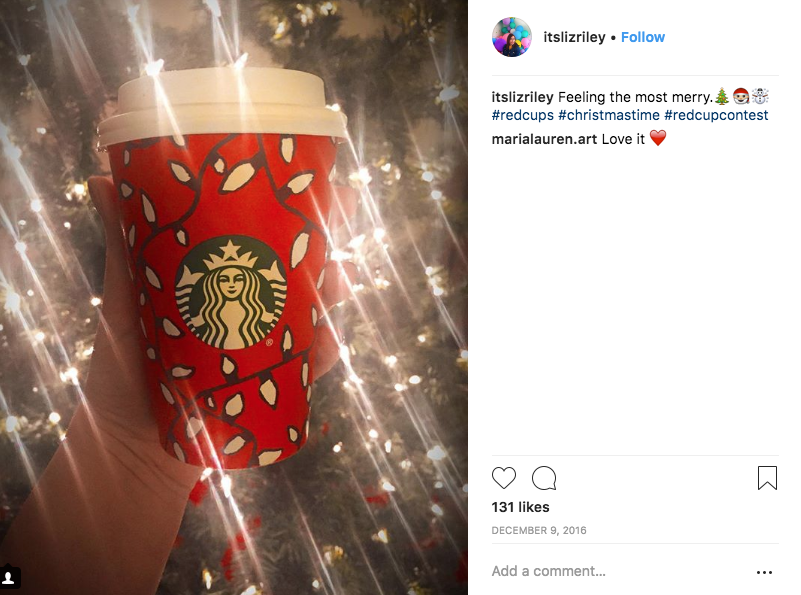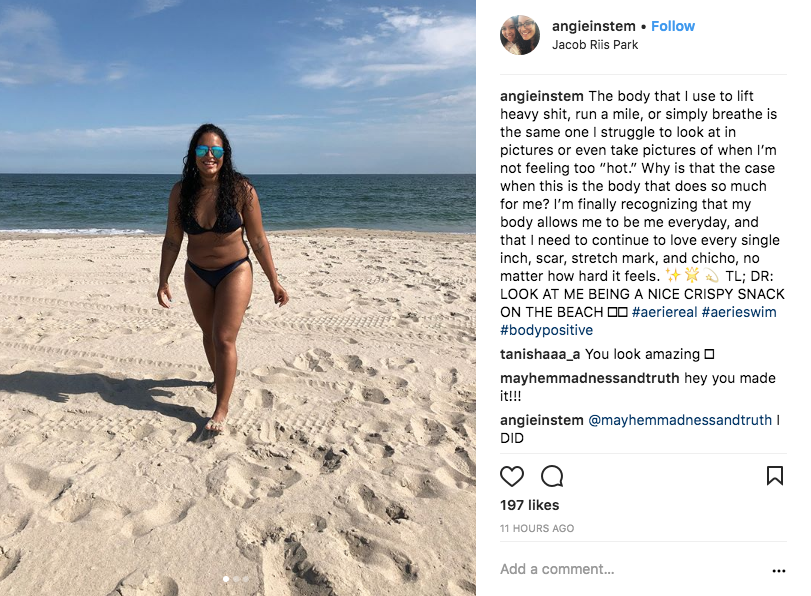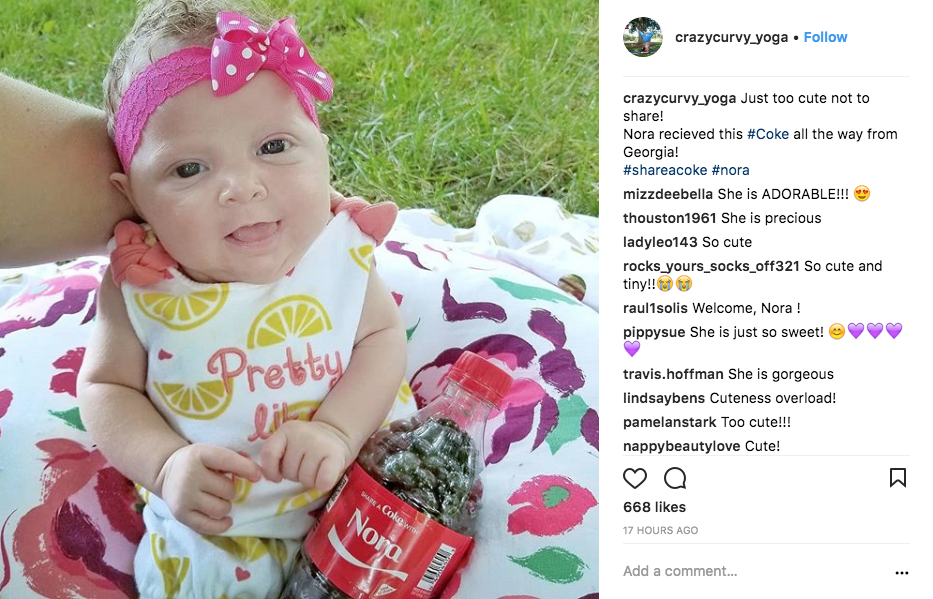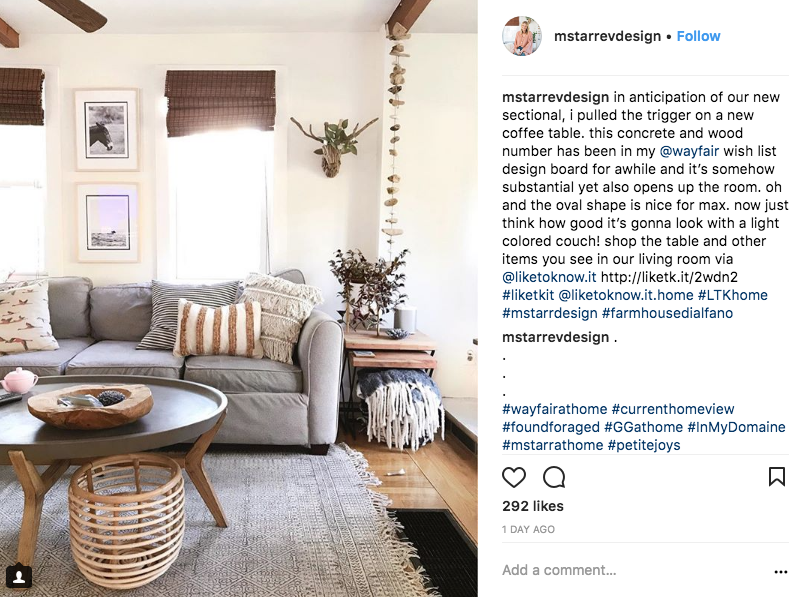Every year at Christmas time, Starbucks launches it’s #RedCupContest to promote it’s seasonal drinks and, of course, the annual red cup. The campaign encourages customers to post pictures of their coffee for a chance to win a gift card. It works, too – at the time of writing there are around 40,000 pictures on Instagram under the hashtag.

This is a great example of a user-generated content campaign. By encouraging users to post content, Starbucks manage to massively increase engagement, promote their seasonal products, and generate sales – you have to buy a drink to take a picture of.
When it comes to making a purchase decision, we’re more likely to take recommendations from friends and family than brands, and that’s the logic behind user-generated content (UGC) on social media.
What is user generated content?
UGC is exactly what it says on the tin. UGC can be in any form – video, blog posts, pictures, tweets, reviews – and can take place across pretty much any platform, although it’s particularly common on Instagram. A brand can then repost or ‘regram’ the content.
UGC isn’t paid for, like some influencer marketing, and it’s that authenticity that makes it so successful. People are posting about a particular brand because they want to, not because they’re being paid to – so it must be good, right?
It’s important to bear in mind that Millenials and Gen Z aren’t really making buying decisions based on advertising any more. We’re becoming much more savvy when it comes to adverts, and it’s becoming harder to influence purchasers with traditional ads. UGC can be a good solution to this – it’s essentially a way of reaching audiences in a way that resonates with them.
What are the benefits of UGC?
It resonates with a younger audience
We already touched on this above, but it’s an important one. Research has show that Gen Z is already on track to become the largest generation of consumers by the year 2020, so it’s vital that you’re able to tap into this market. We also know that traditional advertising just doesn’t speak to Gen Z like it used to. They’re much more consumer savvy, and are attracted to brands that are honest and authentic.
UGC is an ideal way to curate content that promotes your brand without being sales-y. The fact that it’s conducted predominantly over social media also helps. Gen Z are tech natives, and studies have shown that over 85% of the iGen learn about new products and brands on social media. It’s just good sense to take advantage of this; putting your marketing in the places where your audience will see it is a bit of a no-brainer really!
It boosts your social media reach and growth
The more people that interact with you on social media, the more people will see your content, and engage with you. It’s really that simple with social media – engagement = reach. By encouraging your customers to post UGC, you automatically increase your engagement. If you’re using user-generated content, there’s also a good chance that the person who originally posted it will share it with their connections as well.
You can also use a hashtag when curating UGC. In the red cup contest, people used the hashtag #redcupcontest to submit their entries, and so any user that happens across that hashtag will see all of the UGC that’s been uploading. If enough people take part, you might even get your hashtag to trend, which is amazing for exposure. You can learn more about how to use hashtags to power up your marketing in a previous blog post.
It takes pressure off your content marketing team
We all know that good content is the cornerstone of all marketing activity, and we also know that often, marketing teams are just too busy to spend the time it takes to create quality content. UGC takes away some of the pressure, and allows you to curate some great content with minimal effort.
It’s free
Need we say more?
Aside from the time it takes you to set up your campaign, UGC doesn’t have to cost you anything. Other than recognition, you don’t need to give your contributors anything.
User-generated content campaigns that worked
We’ve already mentioned the Starbucks red cup campaign, but here are some more examples of brands using UGC to boost their marketing.
Aerie – #AerieReal
Aerie is a women’s clothing company, and their UGC campaign is simple, but very powerful.
There’s been a lot of outcry in recent years over excessive retouching of images of models, and the effect that it has on women’s self esteem and idea of a healthy body image.
Aerie are looking to combat this with their #AerieReal campaign, and pledged to stop retouching images of models in their swimwear. They encourage their customers to post their unedited pictures in the products and use these instead. They’ve also pledged that for every picture posted, they’ll donate $1 to the National Eating Disorders Association.

So why is this campaign so effective? At the time of writing, there are over 117,000 pictures under the hashtag, which is pretty good going! Aerie is giving people a reason to participate, and customers want to buy from brands that support important causes. If you can, partner with a charity or cause that will get customers excited about your campaign.
Coca-Cola – #ShareACoke
With a whopping 666,503 Instagram posts (at time of writing) under the Share a Coke hashtag, and close to a billion impressions on Twitter, it’s fair to say that the campaign was a huge win for Coca-Cola. The company produced Coke bottles with different names on and asked customers to post pictures of their personalised bottles on social media. The campaign took off all over the world, and massively boosted sales of Coke.

The campaign was so successful, Coca-Cola still use it today, and introduce different iterations of it every summer.
Wayfair – #WayfairAtHome
Furniture retailer Wayfair runs a UGC campaign where customers can use the hashtag to show off their purchases in their own homes. Then, Wayfair reposts the UGC with a link so users can shop for the featured items themselves.

This is a fantastic way to showcase the products, combined with customer testimonials and reviews. Remember, people trust customer reviews over brand advertisements, and showing them being successfully used by real people, it’s easier to get them shopping on your website.
How can you execute your own UGC campaign?
We can see that user-generated content can have a huge amount of value, so here are some practical tips to get you started with your own campaign.
Support a cause
As with Aerie above, brands that support a cause or a charity often win with user-generated content. In addition to helping the world, by aligning your brand with a cause you’ll attract new customers, gain attention from media, and boost brand loyalty with your existing customers.
Users will also be much more likely to contribute to your campaign if they know that by doing so, they’ll be helping that charity or cause. Remember the ice bucket challenge? The sheer volume of content and awareness that generated was mind-boggling, and it started because it was to support the ASL charity.
Offer a prize
A sure-fire way to encourage users to contribute to your campaign is offering a prize for the best entry. It also means you’ll get some great content, as users will be posting their best pictures to be in with a chance of winning.
Just remember to keep your prize in line with what you’re asking users to do. If you’re offering a large sum of money, for example, you want to make sure you get your money’s worth. Make sure you ask users to demonstrate a more substantial level of buy-in than you would if you were offering something smaller like vouchers or discounts.
Ask questions
Asking questions can encourage your followers to create content, and is also a really good way of getting useful feedback from customers. Try asking how your products have improved your customer’s lives, or about their personal experiences with your brand.
Be careful though, as there are sometimes negative answers to these questions. In 2012, McDonalds ran the #McStories campaign, which quickly backfired when users started sharing their bad experiences with the brand.
When used well, asking questions will help to facilitate engagements. Remember, people always appreciate it when they’re genuinely asked for their opinions.
Tap into influencers
Influencer marketing is huge these days, and really warrants a blog post all of its own (maybe we should write one!) but it does tie in nicely with UGC. Social and digital influencers are seen as experts in their area and usually have enormous social followings. If you can get an influencer to post some UGC featuring your product (warning: you’ll probably have to pay them) you could see an upswing in sales and brand awareness within an hour of the picture being posted.
It will also help with your organic content – consumers who see influencers using a particular product are likely to join the conversation by submitting their own contributions.
Get permission
Remember to get permission from users to share their content. Most of the time, they’ll be more than happy for you to use their content and it might feel a bit pointless to ask. However, that user does own the copyright to their content and if you don’t have their permission you could get into trouble.
You should always credit the user when you repost their content, whether you add their name and handle to the picture or tag them in it, crediting them as the creator. Really though, you should tag them in the content regardless – if you don’t they and their friends won’t see it and you’re missing out on a ton of engagement.
Final Thoughts
These days, people are spending more and more time on social media, and more of their purchase decisions are influenced by user-generated content. Curating UGC will help to generate a buzz around your brand, and improve your brand awareness, social media engagement, and trust with your audience.
It’s not necessarily simple to do, and there are some pitfalls you need to be wary of, but if done well UGC is a form of content marketing that can be incredibly effective. Plus, if someone else is creating the content, it’s one less thing for you to do – win-win!
For help creating a user-generated content strategy, get in touch with our content marketing team; they’ll be happy to help.


